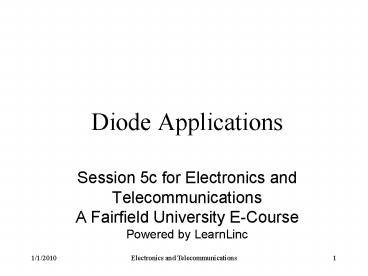Diode Applications - PowerPoint PPT Presentation
1 / 14
Title:
Diode Applications
Description:
Electronics Tutorial (Thanks to Alex Pounds) Electronics Tutorial ... IR = (VS VZ) / R. 12/4/09. Electronics and Telecommunications. 9. Zener (continued) ... – PowerPoint PPT presentation
Number of Views:70
Avg rating:3.0/5.0
Title: Diode Applications
1
Diode Applications
- Session 5c for Electronics and Telecommunications
A Fairfield University E-CoursePowered by
LearnLinc
2
Module Semiconductor Electronics(in two parts)
- Text Electronics, Harry Kybett, Wiley, 1986,
ISBN 0-471-00916-4 - References
- Electronics Tutorial (Thanks to Alex Pounds)
- Electronics Tutorial (Thanks to Mark Sokos)
- Semiconductors, Diodes and Bipolar Transistors
- 5 on-line sessions plus one lab
- FETs, SCRs, Other Devices and Amplifiers
- 5 on-line sessions plus one lab
- Mastery Test part 3 follows this Module
3
Section 5 Semiconductors, Diodes and Bipolar
Transistors
- 0BJECTIVES This section reviews semiconductors,
doping and junctions. The characteristics and
application of Diodes and Bipolar Transistors are
then studied.
4
Section 5 Schedule
Elect 1-7 1.23 1.39 Kybett Chapter 2
Kybett Chapter 11 Kybett pp 51 - 70
Kybett pp 173 - 201
Semiconductors and Doping Well discuss
MT2DiodesDiode Applications Bipolar
Transistors Transistor Amplifiers Review
(Discuss Quiz 4)About 2 weeks to set up the
computers and retrain us
Session 5a 09/18 MT2 Results
09/23 Session 5b 09/25 Session 5c
09/30 Session 5d 10/02 (lab -
10/05, Sat.) Session 5e 10/07 (Quiz
4 due 10/12)Session 5f 10/14Break
to introduce Learnlinc version 6.1
5
Diode Review
- Diodes are electronic one-way valves
- Current can flow from anode to cathode
- Current is blocked in the reverse direction
- Forward voltage drop
- Silicon Vf 0.7 volts
- Germanium Vf 0.3 volts
- Schottky Vf 0.1 volts
- GaAs Vf 2 volts
- Peak Inverse Voltage (PIV, PRV, Zener)
- These are non-linear devices ( no superposition )
6
Diode VI Curve
7
A Diode Circuit
- What is the loop current?
- The resistor voltage isVr 3 0.7 2.3 volts
- Using Ohms LawIr 2.3 / 1000 2.3 mAwhich is
also the loop current
8
Zener Diode Application(Shunt Voltage Regulator)
- Kybett pp 42-47 ( Problems 26 47 )
- Zener diodes operate in reverse breakdown.Series
resistor limits the current to a safe level.IR
(VS VZ) / R
9
Zener(continued)
- Determine resistor to maintain voltage/current
for light at specifications - If the source voltage drops the light dims
- 29 30. Put a 20v zener across the bulb and
redesign resistor for the worst case (35v source) - 31. At 50v the bulb remains at 20v the zener now
conducts the excess current and the bulb remains
at specifications - 32 - 34. Determine maximum power dissipation for
the zener diode and the resistor (avoid burn out
at 50v).
10
Half Wave Rectifier
- Current flows during the positive half of the AC
sine wave - Current is blocked during the negative half of
the AC sine wave - The pulse output waveform has a non-zero average
value (a DC component)
11
Full Wave Rectifiers
- Center tapped transformer produces two AC sine
waves, 180º apart - The diodes produce positive pulse waveforms
during opposite halves of the input sine wave - They add in the load. The time between peaks is
half that of the half-wave rectifier (more
efficient producer of DC)
12
Bridge Rectifiers
- Another form of full-wave rectifier
- Doesnt require a center-tapped transformer
- Transformer secondary now floats at ½ the DC
output voltage (assuming that the load is
connected to ground)
13
DC Power Supply
- Now the diode conducts to charge the capacitor to
peak AC voltage. - The capacitor discharges between peaks of the
source pulses - Result an average (DC) of about 80 of the AC
peak and a small saw tooth AC ripple voltage. - A full-wave rectifier produces smaller ripple
(less time between pulses)
14
Section 5 Schedule
Elect 1-7 1.23 1.39 Text Chapter 2 Text
Chapter 11 Text pp 51 - 70 Text pp 173
- 201
Semiconductors and Doping Well discuss
MT2DiodesDiode Applications Bipolar
Transistors Transistor Amplifiers Review
(Discuss Quiz 4)About 2 weeks to set up the
computers and retrain us
Session 5a 09/18 MT2 Results
09/23 Session 5b 09/25 Session 5c
09/30 Session 5d 10/02(lab -
10/05, Sat.) Session 5e 10/07 (Quiz
4 due 10/12)Session 5f 10/14Break
to introduce Learnlinc version 6.1































